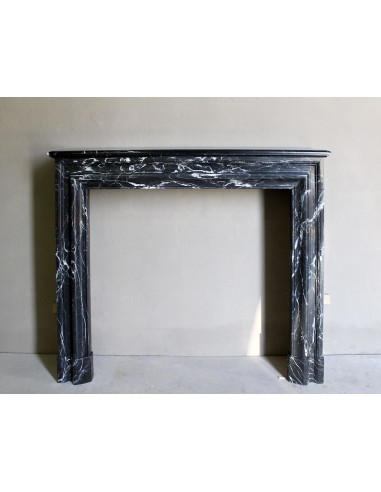Yes,“IMPOSING” is an adjective that goes well with this fireplace mantel because this is precisely the first feature that “jumps out at the eye” of anyone who sees it.. It is above all its height (cm 123, about twenty cm more than the average of the ancient nineteenth-century fireplaces) that leads us to consider this mantelpiece … “IMPOSING.” Its width (cm 145), after all, is that of many ancient fireplaces, particularly the mantels that adorned the 'most important (and therefore the BIGGEST) room, the Salone.
The birth of the particular profile of this mantel , although its name (Boudin") is French, dates back, in that of Naples, to the middle of the Milleseicento and we owe it to the pencil and imagination of a more than multifaceted Artist (great painter, very fine engraver, interesting writer and poet, even theater actor!!) who invented the lines (revolutionary for the Antique..) of this mantel not to make a fireplace, but to frame the canvases of his paintings.. Our Savior flew to heaven around 1670, and a few decades later French architects appropriated this artistic novelty and somehow made this delightful and original mantel frame their own, changing it into a fireplace frame and giving it a name, of course. French. And do you know where the mantel debuted that in Italy we call “Cornice Salvator Rosa”?! None other than... AT THE PALACE OF VERSAILLES!!! Many of the 1264 fireplaces at Versailles had the “hearth area” circled by the Salvator Rosa mantel!!! LET US GIVE CAESAR HIS DUE.
The Salvator Rosa mantel became a real fireplace(and not just the hearth frame) in the mid-19th century (1840-60), thanks to a builder/sculptor who had two sculpture workshops, one in Masiglia and one in Nice.. It was a great success, a kind of stylistic revolution on the threshold of the Art Nouveau period, indeed, in my opinion, this Boudin fireplace, with its bold, almost “geometric” but refined, modern but elegant stylism, to me could be considered a forerunner of the Art Deco MODERNISM TO COME.
Its Marquinia marble is a choice of great quality, just look at the fineness of its fine, elegant and very white veining.
Perfectly preserved, “right” period of construction (mid-nineteenth century), found in the city of Lyon.
The only thing I don't find right is its price, in my opinion rather low, I wouldn't want our Salvator Rosa to be offended by it, I will therefore tell my son Enrico that he should take action on the matter.


































































